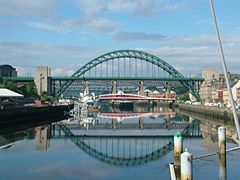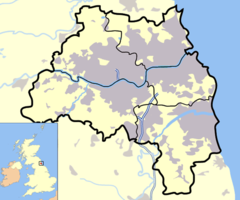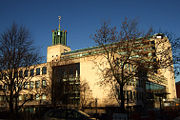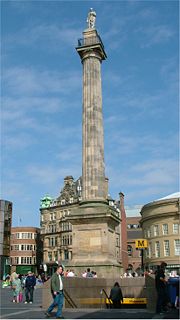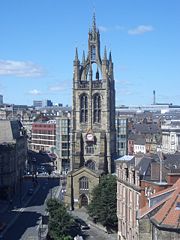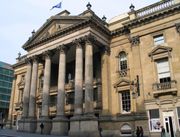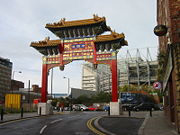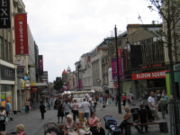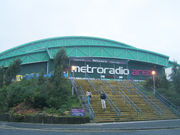Newcastle upon Tyne
2008/9 Schools Wikipedia Selection. Related subjects: British Cities; Great Britain
| Newcastle upon Tyne | |
|
Newcastle upon Tyne shown within Tyne and Wear |
|
| Population | 259,536 |
|---|---|
| OS grid reference | |
| Metropolitan borough | Newcastle City Council |
| Metropolitan county | Tyne and Wear |
| Region | North East |
| Constituent country | England |
| Sovereign state | United Kingdom |
| Post town | NEWCASTLE UPON TYNE |
| Postcode district | NE1-NE7, NE12-NE13, NE15 |
| Dialling code | 0191 |
| Police | Northumbria |
| Fire | Tyne and Wear |
| Ambulance | North East |
| European Parliament | North East England |
| UK Parliament | Newcastle upon Tyne Central |
| Newcastle upon Tyne East and Wallsend | |
| Newcastle upon Tyne North | |
| Tyne Bridge | |
| List of places: UK • England • Tyne and Wear | |
Coordinates:
Newcastle upon Tyne ( pronunciation ) (often shortened to Newcastle) is a city in Tyne and Wear, England, historically part of the English county of Northumberland. The city lies on the banks of the River Tyne. The city owes its name to the Norman castle built in 1080, by Robert II of Normandy, the eldest son of William the Conqueror.
The area around Newcastle was historically a Roman settlement. The city grew as an important centre for the wool trade and it later became a major coal mining area. The port developed in the 16th century and, along with the shipyards lower down the river was amongst the world's largest shipbuilding and ship-repairing centres. The city is also an educational centre, with two universities.
A city was founded in the 2nd century, during the times of Roman occupation, under the name Pons Aelius. The medieval Latin name is Novum Castrum super Tynum (Newcastle upon Tyne). The city is the 20th most populous in England; the larger Tyneside conurbation, of which Newcastle forms part, is the sixth most populous conurbation in the United Kingdom. Newcastle is a member of the English Core Cities Group and (with Gateshead) the Eurocities network of European cities.
People from Newcastle and surrounding areas are commonly called Geordies. The Latin term Novocastrian can equally be applied to residents of any place called Newcastle.
History
Early development
The first settlement in what is now Newcastle was Pons Aelius, designating the bridge across the Tyne and given the family name of the Roman Emperor Hadrian who founded it in the 2nd century AD. The population of Pons Aelius at this period was estimated at 2,000. Hadrian's Wall is still visible in parts of Newcastle, particularly along the West Road. (The course of the "Roman Wall" can also be traced eastwards to the Segedunum Roman fort in Wallsend - the wall's end). The extent of Hadrian's Wall was 73 miles (117 km), spanning the width of Britain; the wall incorporated Agricola's Ditch and was constructed primarily to prevent unwanted immigration from the north, not as a fighting line for a major invasion.
After the Roman withdrawal from Britain, Newcastle became part of the powerful Anglo-Saxon kingdom of Northumbria, and became known throughout this period as Monkchester. After a series of conflicts with the Danes and the devastation north of the River Tyne inflicted by Odo of Bayeux after the 1080 rebellion against the Normans, Monkchester was all but destroyed. Because of its strategic position, Robert Curthose, son of William the Conqueror, erected a wooden castle there in the year 1080 and the town was henceforth known as Novum Castellum or New Castle.
Throughout the Middle Ages, Newcastle was England's northern fortress. A 25-foot (7.6 m) high stone wall was built around the town in the 13th century, to defend it from invaders during the Border war against Scotland. The Scots king William the Lion was imprisoned in Newcastle in 1174, and Edward I brought the Stone of Scone and William Wallace south through the town. Newcastle was successfully defended against the Scots three times during the 14th century, and around this time became a county corporate.
From 1530 a royal act restricted all shipments of coal from Tyneside to Newcastle quayside, giving a monopoly in the coal trade to a cartel of Newcastle burgesses known as the Hostmen. This monopoly, which lasted for a considerable time, helped Newcastle prosper, but it had its impact on the growth of near-neighbours Sunderland, causing a Tyneside and a Wearside rivalry that still exists. In the Sandgate area, to the east of the city and beside the river, resided the close-knit community of keelmen and their families. They were so called because they worked on the keels, boats that were used to transfer coal from the river banks to the waiting colliers, for export to London and elsewhere. During the English Civil War, Newcastle supported the king and in 1644 was stormed ('with roaring drummes') by Cromwell's Scots allies, based in pro-Parliament Sunderland. The grateful King bestowed the motto "Fortiter Defendit Triumphans" ("Triumphing by a brave defence") upon the town. Ironically, Charles was imprisoned in Newcastle by the Scots in 1646-7.
In the 18th century, Newcastle was the country's largest print centre after London, Oxford and Cambridge, and the Literary and Philosophical Society of 1793, with its erudite debates and large stock of books in several languages, predated the London Library by half a century. Newcastle also became the greatest glass producer in the world.
Newcastle's development as a major city, however, owed most to its central role in the export of coal. The phrase taking coals to Newcastle was first recorded in 1538. In the 19th century, shipbuilding and heavy engineering were central to the city's prosperity; and the city was a powerhouse of the Industrial Revolution. Innovation in Newcastle and surrounding areas included the development of safety lamps, Stephenson's Rocket, Lord Armstrong's artillery, Be-Ro flour, Joseph Swan's electric light bulbs, and Charles Parsons' invention of the steam turbine, which led to the revolution of marine propulsion and the production of cheap electricity.
Heavy industries in Newcastle declined in the second half of the 20th century; office and retail employment are now the city's staples.
Urban development
In large parts, Newcastle still retains a medieval street layout. Narrow alleys or 'chares', most of which can only be traversed by foot, still exist in abundance, particularly on the riverside. Stairs from the riverside to higher parts of the city centre and the extant Castle Keep, originally recorded in the 14th century, remain in their places. Close, Sandhill and Quayside contain modern buildings as well as structures dating from the 15th-18th centuries, including Bessie Surtees House, the Cooperage and Lloyds Quayside Bars, Derwentwater House and the currently unused Grade I-listed 16th century merchant's house at 28-30 Close.
The city has an extensive neoclassical centre, largely developed in the 1830s by Richard Grainger and John Dobson, and recently extensively restored. Broadcaster and writer Stuart Maconie describes Newcastle as England's best-looking city and Grey Street, which curves down from Grey's Monument towards the valley of the River Tyne, was voted as England's finest street in 2005 in a survey of BBC Radio 4 listeners. A portion of Grainger Town was demolished in the 1960s to make way for the Eldon Square Shopping Centre, including all but one side of the original Eldon Square itself.
Immediately to the northwest of the city centre is Leazes Park, established in 1873 after a petition by 3,000 working men of the city for "ready access to some open ground for the purpose of health and recreation". Just outside one corner of this is St James' Park, the stadium home of Newcastle United F.C. which dominates the view of the city from all directions.
Another green space in Newcastle is the vast Town Moor, lying immediately north of the city centre. It is larger than Hyde Park and Hampstead Heath put together and the freemen of the city have the right to graze cattle on it. Unlike other cities where similar rights exist, they often take advantage of this, leading to the somewhat bizarre sight of cattle grazing within yards of the city's town hall, Newcastle Civic Centre. The right incidentally extends to the pitch of St James' Park, Newcastle United Football Club's ground, though this is not exercised,although the Freemen do collect rent for the loss of privilege. Honorary freemen include Bob Geldof, Nelson Mandela, Alan Shearer and the Royal Shakespeare Company. The Hoppings funfair, said to be the largest travelling fair in Europe, is held here annually in June. In the south eastern corner is Exhibition Park, which is home to the Newcastle Military Vehicle Museum.
The wooded gorge of the Ouseburn in the east of the city is known as Jesmond Dene and forms another popular recreation area, linked by Armstrong Park and Heaton Park to the Ouseburn Valley, where the river finally reaches the River Tyne.
Newcastle was voted as the Best City in the North in April 2007 by The Daily Telegraph newspaper - beating Liverpool, Manchester, Sheffield and Leeds in an online poll conducted of its readers.
Recent developments
The development of the city in the 1960s and 1970s saw the demolition of part of Grainger Town as a prelude to the modernist rebuilding initiatives of T. Dan Smith, the leader of Newcastle City Council. A corruption scandal was uncovered involving Smith and John Poulson, a property developer, and both were jailed. Echoes of the scandal were revisited in the late 1990s in the BBC TV mini-series, Our Friends in the North.
The Tyne Gorge between Newcastle on the north bank and Gateshead (an administratively separate borough) on the south bank, is famous for a series of dramatic bridges, including the Tyne Bridge of 1928 which was built by Dorman Long of Middlesbrough, and Robert Stephenson's High Level Bridge of 1849, the first road/rail bridge in the world. Large-scale regeneration has replaced former shipping premises with imposing new office developments; an innovative tilting bridge, the Gateshead Millennium Bridge was commissioned by Gateshead and has integrated the older Newcastle Quayside more closely with major cultural developments in Gateshead, including the BALTIC Centre for Contemporary Art and the Norman Foster-designed The Sage Gateshead music centre. Newcastle & Gateshead Quayside is now a thriving, cosmopolitan area with an abundance of bars, restaurants and public spaces. As a tourist promotion, Newcastle and Gateshead have linked together under the banner " NewcastleGateshead", to spearhead the regeneration of the north east.
Notable Newcastle housing developments include Ralph Erskine's the Byker Wall designed in the 1960s and now Grade II* listed. It is on UNESCO's list of outstanding 20th century buildings.
Newcastle's thriving Chinatown lies in the north-west of Grainger Town, centred on Stowell Street. A new Chinese arch, or paifang, providing a landmark entrance, was handed over to the city with a ceremony in 2005.
The UK's first biotechnology village, the " Centre for Life" is located in the city centre close to the Newcastle Central railway station. The village is the first step in the City Council's plans to transform Newcastle into a science city.
The River Tyne will have a brand new bridge ( Bambuco Bridge) in 2008 but only for 10 days, it was not made for walking, road or cycling, it is just a sculpture.
Governance
Newcastle is governed using the leader and cabinet system, and the executive is Liberal Democrat, as they have 48 councillors against the Labour Party's 30. No other parties hold seats on the city's council.
For the purposes of City Council elections, Newcastle is divided into 26 electoral wards.
|
|
Geography
Newcastle is situated in the North East of England, in the ceremonial county of Tyne and Wear and the historical and traditional county of Northumberland. The city itself is located on the northern bank of the River Tyne at a latitude of 54.974° N and a longitude of 1.614° W.
The geology of the area is most famous for its large deposits of coal. Whilst the local bedrock consists mainly of carboniferous rocks, millstone grit and oolite are also present.
The climate in Newcastle is temperate, although significantly warmer than some other locations at a similar latitude due to the warming influence of the Gulf Stream (via the North Atlantic Drift). Being in the rain shadow of the North Pennines, it is among the driest cities in the UK.
Demography
Population
According to the UK Government's 2001 census, the city of Newcastle has a population of 189,863, whereas the unitary authority of Newcastle has a population of around 259,500. However, the metropolitan boroughs of North Tyneside (population c.190,000), South Tyneside (population c. 150,000) and Gateshead (population c.200,000) are also part of the Tyneside conurbation, giving the Newcastle-Gateshead metropolitan area a population of 799,000. According to the same statistics, the average age of people living in Newcastle is 37.8 (the national average being 38.6). 93.1% of the population are of white British ethnic background (the national average being 91.3%). Many people in the city have Scottish and Irish ancestors. There is a strong presence of Border Reiver surnames, such as Armstrong, Robson, Charlton, Kerr, Elliot, Hall etc. Other ethnic groups in Newcastle, in order of population size, are Pakistani at 1.9% and Indians at 1.2%. There are also small but significant Chinese, Jewish and Eastern European (Polish, Czech Roma) populations.
The city is largely Christian at 70.6%; Muslims are 3.6%, and a large number (over 16%) have no religion.
According to latest figures, the city's ethnic make-up is as follows:
- White – 90.5%
- S.Asian – 5.2%
- Black – 1.1%
- Chinese – 1.1%
- Mixed-race – 1.2%
- Other – 0.8%
Health
Newcastle Hospitals NHS Foundation Trust has one of the lowest mortality rates in the country and is ranked seventh in the country for confidence in doctors. Newcastle has three large teaching hospitals: the Royal Victoria Infirmary, the Newcastle General Hospital and the Freeman Hospital, which is also a pioneering centre for transplant surgery.
In a report, published in early February 2007 by the Ear Institute at the University College London, and Widex, a Danish hearing aid manufacturer, Newcastle was named as the noisiest city in the whole of the UK, with an average level of 80.4 decibels. The report claimed that these noise levels would have a negative long-term impact on the health of the city's residents. The report was criticised, however, for attaching too much weight to readings at arbitrarily selected locations, which in Newcastle's case included a motorway underpass without pedestrian access.
Transport and infrastructure
National and international
Air
Newcastle International Airport is located approximately 6 miles (9.7 km) from the City Centre on the northern outskirts of the city near Ponteland. The airport handles over five million passengers per year, and is the tenth largest, and the fastest growing regional airport in the UK, expecting to reach 10 million passengers by 2016, and 15 million by 2030. As of 2007, over 90 destinations are available world-wide.
Rail
Newcastle Central railway station is a principal stop on the East Coast Main Line and Cross Country Route. Opened in 1850 by Queen Victoria, it was the first covered railway station in the world and was much copied across the UK. It has a neoclassical facade, originally designed by the architect John Dobson, and was constructed in collaboration with Robert Stephenson. The first services were operated by the North Eastern Railway company. The city's other mainline station, Manors, is to the east of the city centre.
Train operator National Express East Coast provides a half-hourly frequency of trains to London, with a journey time of a about three hours. CrossCountry and First TransPennine Express operate regular services to many major destinations, whereas Northern Rail provides local and regional services.
Road
Major roads in the area include the A1 (Gateshead Newcastle Western Bypass), stretching north to Edinburgh and south to London; the A19 heading south past Sunderland and Middlesbrough to York and Doncaster; the A69 heading west to Carlisle; the A167, the old "Great North Road", heading south to Gateshead, Chester-le-Street, Durham and Darlington; and the A1058 "Coast Road", which runs from Jesmond to the east coast between Tynemouth and Cullercoats. Many of these designations are recent—upon completion of the Western Bypass, and its designation as the new line of the A1, the roads between this and the former line through the Tyne Tunnel were renumbered, with many city centre roads changing from a 6-prefix to their present 1-prefix numbers.
Water
Newcastle has access to an international Ferry Terminal, at North Shields, which offers services to destinations including Amsterdam, Stavanger, Haugesund and Bergen. A ferry to Gothenburg, Sweden, operated by Danish DFDS Seaways, ceased crossing at the end of October 2006. The company cited high fuel prices and new competition from low-cost air services as the cause. DFDS Seaways' sister company, DFDS Tor Line, will continue to run scheduled freight ships between Gothenburg and several English ports, with limited capacity for passengers. From summer 2007, Thomson cruise lines includes Newcastle as a port of call on its Norwegian and Fjords cruise.
Local
Bus
Operating from the hubs of Eldon Square Bus Station and Haymarket Bus Station, Newcastle upon Tyne and the surrounding area has an extensive bus network that is coordinated by Nexus, the Tyne and Wear Passenger Transport Executive. Buses are operated mainly by Arriva Northumbria, Go North East and Stagecoach North East. QuayLink is a hybrid electric bus service operated to the Quayside.
Metro
The city is served by the Tyne and Wear Metro, a system of suburban and underground railways covering most of Tyne and Wear. It was opened in five phases between 1980 and 1984, and was Britain's first urban light rail transit system; two extensions were opened in 1991 and 2002. It was developed from a combination of existing and newly built tracks and stations, with deep-level tunnels constructed through Newcastle city centre. A bridge was built across the Tyne, between Newcastle and Gateshead, and opened by Queen Elizabeth II in 1981. The network is operated by Nexus and carries over 37 million passengers a year, extending as far as Newcastle Airport, Tynemouth and South Hylton in Sunderland.
Cycle
Newcastle city centre is a relatively cycle-unfriendly one, providing no bicycle lanes. However the C2C cycle route runs along the north bank of the River Tyne enabling cyclists to travel off-road to North Shields and Tynemouth in the east and westwards towards Hexham. Furthermore, in the suburbs there are extensive cycle routes utilising the converted trackbeds of former industrial wagonways and industrial railways.
There are also on-road cycle lanes on main roads leading from the centre to the suburbs of Gosforth, Heaton and Wallsend. The tourist information centre in the city centre provides a free cycle map of Tyne and Wear.
Education
The city has two universities. Established as a School of Medicine and Surgery in 1834, and becoming independent from Durham University in 1963, Newcastle University is now one of the UK’s leading international universities. It won the coveted Sunday Times University of the Year award in 2000. Newcastle Polytechnic was granted university status in 1992, becoming the University of Northumbria at Newcastle. Northumbria University, as it is currently known, was voted 'Best New University' by The Times Good University Guide 2005. The latter university also won a much coveted company award of the "Most IT enabled organisation" (in the UK), by the IT industry magazine Computing.
There are eleven LEA-funded 11 to 18 schools and seven independent schools with sixth forms in Newcastle. There are a number of successful state schools, including Gosforth High School, Heaton Manor School, St Cuthbert's High School, Kenton Comprehensive School and Sacred Heart. The largest co-ed independent school is the Royal Grammar School. The largest girls' independent school is Central Newcastle High School. Both schools are located on the same street in Jesmond. Newcastle College is the largest general further education college in the North East and is a beacon status college; there are two smaller colleges in the Newcastle area.
Religious sites
Newcastle has two cathedrals, the Anglican St. Nicholas, with its elegant lantern tower of 1474, and the Roman Catholic St. Mary's, designed by Augustus Welby Pugin. Both cathedrals began their lives as parish churches. St Mary's became a cathedral in 1850 and St Nicholas' in 1882. Newcastle was a prominent centre of the Plymouth Brethren movement up to the 1950s and some small congregations still function. Among these are at the Hall, Denmark Street and Gospel Hall, St Lawrence.
One of the largest evangelical Anglican churches in the UK is Jesmond Parish Church, situated a little to the north of the city centre.
Sport
The City has a strong sporting tradition. Premier League football team Newcastle United has been based at St James' Park since the club was established in 1892. The city also has two non-League football teams, Newcastle Blue Star and Newcastle Benfield. Also based in Newcastle are Guinness Premiership rugby union side Newcastle Falcons.
The Metro Radio Arena is home to Newcastle Vipers ice hockey team and Newcastle Eagles basketball team. The city's speedway team Newcastle Diamonds are based at Brough Park in Byker, a venue that is also home to greyhound racing. The first track to open in Newcastle was at Goford Stadium but this only operated until 1930. Newcastle Racecourse at High Gosforth Park holds regular meets, including the prestigious race for the Northumberland Plate, first run in 1838, which takes place in June each year.
Newcastle also hosts the start of the annual Great North Run, the world's largest half-marathon in which participants race over the Tyne Bridge into Gateshead and then towards the finish line 13.1 miles (21.1 km) away on the coast at South Shields. Another famous athletic event is the 5.7-mile (9.2 km) Blaydon Race (a road race from Newcastle to Blaydon), which has taken place on 9 June annually since 1981, to commemorate the celebrated Blaydon Races horse racing.
Culture
Dialect
The dialect of Newcastle is known as Geordie, and contains a large amount of vocabulary and distinctive word pronunciations not used in other parts of England. The Geordie dialect has much of its origins in the language spoken by Anglo-Saxon mercenaries, who were employed by the Ancient British people to fight Pictish invaders, following the withdrawal of the Romans from Britain in the 4th century. This language was the forerunner of Modern English; but while the dialects of other English regions have been heavily altered by the influences of other foreign languages—particularly Latin and Norman–French—the Geordie dialect retains many elements of the old language. An example of this is the pronunciation of certain words: "dead", "cow", "house" and "strong" are pronounced "dede", "coo", "hoos" and "strang"—which is how they were pronounced in the Anglo-Saxon language. Other Geordie words with Anglo-Saxon origins include: "larn" (from the Anglo-Saxon "laeran", meaning "teach"), "burn" ("stream") and "gan" ("go"). Some words used in the Geordie dialect are used elsewhere in the northern United Kingdom. The words "bonny" (meaning "pretty"), "howay" ("come on"), "stot" ("bounce") and "hadaway" ("go away" or "you're kidding"), all appear to be used in Scottish dialect; "aye" ("yes"), "chuffed" ("happy") and "nowt" (IPA://naʊt/, rhymes with out,"nothing") are used elsewhere in northern England. Many words, however, appear to be used exclusively in Newcastle and the surrounding area, such as "Canny" (a versatile word meaning "good", "nice" or "very"), "bait" ("food"), "hacky" ("dirty"), "netty" ("toilet") and "hoy" ("throw").
Nightlife
Newcastle has a reputation for being a fun-loving city with many bars, restaurants and nightclubs. More recently, Newcastle has become popular as a destination for Stag and Hen parties. Newcastle was in the top ten of the country's top night spots, and The Rough Guide to Britain placed Newcastle upon Tyne's nightlife as Great Britain's no. 1 tourist attraction.
There are notable concentrations of pubs, bars and nightclubs around the Bigg Market, and the Quayside area of the city centre. There are many bars on the Bigg Market, and other popular areas for nightlife are Collingwood Street, Neville Street, the Central Station area and Osborne Road in the Jesmond area of the city. In recent years " The Gate" has opened in the city centre, a new indoor complex consisting of bars, upmarket clubs, restaurants and a 12-screen Empire multiplex cinema.
Focused on the Times Square area near the Centre for Life, the "Pink Triangle" is the centre of Newcastle's gay scene and hosts many bars and pubs and two clubs. The community has seen much expansion in the past five years, with further growth planned in the future.
The city has a wide variety of restaurants such as Italian, Indian, Persian, Japanese, Greek, Mexican, Spanish, American, Polish, Malaysian, French, Mongolian, Moroccan, Thai and has a Chinese village with many Chinese restaurants on Stowell Street. There has also been a growth in premium restaurants in recent years with top chefs.
The biggest noticeable difference in the last ten years has been increased opening hours, more upmarket bars, a greater range of clubs and some of the older traditional pubs closing, although many have been revamped and remain very popular.
Theatre
The city contains many theatres. The largest, the Theatre Royal on Grey Street, first opened in 1837. It has hosted a season of performances from the Royal Shakespeare Company for over 25 years, as well as touring productions of West End musicals. The Journal Tyne Theatre hosts smaller touring productions, whilst other venues feature local talent. Northern Stage, formally known as the Newcastle Playhouse and Gulbenkian Studio, hosts various local, national and international productions in addition to those produced by the Northern Stage company. Other theatres in the city include the Live Theatre, the People's Theatre, the Round and the Jubilee Theatre. NewcastleGateshead was voted in 2006 as the arts capital of the UK in a survey conducted by the Artsworld TV channel.
Festivals and fairs
In February, Newcastle's Chinatown is at the centre of a carnival of colour and noise as the city celebrates the Chinese New Year. This year's 2008 Chinese New Year event will also herald the launch of a new festival called EAST'08. The festival programme will have a Chinese theme celebrating the best of contemporary Chinese culture. In late February, NewcastleGateshead jointly hosts, with Sunderland and Middlesbrough, the bi-annual AV Festival. The AV Festival is the UK’s largest international festival of electronic arts, and features visual art, music and moving image. In early March there is the NewcastleGateshead Comedy Festival, this event makes a return to the region since the last event in 2006, it is hoped it will now continue as an annual event.
The Newcastle Beer Festival, organised by CAMRA, takes place in April. In May, Newcastle and Gateshead host the Evolution Festival, a music festival held on the Newcastle and Gateshead Quaysides over the Spring bank holiday, with performances by acts from the world of Rock, Indie and Dance music. EAT! NewcastleGateshead, a festival of food and drink, takes place in May 2008, following a successful pilot event in April 2007.
The Hoppings, reputedly the largest travelling fair in Europe, takes place on Newcastle Town Moor every June. The event has its origins in the Temperance Movement during the early 1880s and coincides with the annual race week at High Gosforth Park. Newcastle Community Green Festival, which claims to be the UK’s biggest free community environmental festival, also takes place every June, in Leazes Park. The Northern Rock Cyclone, a cycling festival, takes place within, or starting from, Newcastle in June. The Ouseburn Festival, a family oriented weekend festival near the city centre, incorporating a "Family Fun Day" and "Carnival Day", is held in late July.
Newcastle Mela, held on the late August bank holiday weekend, is an annual two-day multicultural event, blending drama, music and food from Punjabi, Pakistani, Bengali and Hindu cultures. NewcastleGateshead also holds an annual International Arts Fair. The 2008 event will be held in the Norman Foster designed Sage Gateshead Music and Arts Centre in September. In October, there is the Design Event festival—an annual festival providing the public with an opportunity to see work by regional, national and international designers. The Newcastle Science Festival will be held at the start of October this year, and will include a variety of events, including exhibitions, performances, talks and readings.
Shopping
There are several major shopping areas in Newcastle city centre. The largest of these is the Eldon Square Shopping Centre, which incorporates the first and largest Fenwick department store, and a John Lewis store which is often cited as the first department store in the world. Eldon Square is currently undergoing a full redevelopment. A new bus station, replacing the old underground bus station, was officially opened in March 2007. The wing of the centre, including the undercover Green Market, near Grainger Street and The Gate was demolished in 2007 so that the area can be redeveloped.
The main shopping street in the city is Northumberland Street. In a 2004 report, it was ranked as the most expensive shopping street in the UK for rent, outside of London. Other shopping centres in Newcastle include the relatively modern Eldon Garden and Monument Mall complexes, the Newgate Centre, Central Arcade and the traditional Grainger Market. Outside the city, the largest suburban shopping areas are Gosforth and Byker. The largest indoor shopping centre in Europe, the MetroCentre, is located in Gateshead. The largest Tesco store in the United Kingdom is located in Kingston Park on the edge of Newcastle.
Music
Bands and musicians
The 1960s saw the internationally successful rock group, The Animals, emerge from Newcastle night spots such as Club A-Go-Go on Percy Street, the 1980s saw Geordie singer Brian Johnson join Australian supergroup AC/DC. Other well-known acts with connections to the city include Sting, Bryan Ferry, Dubstar, Dire Straits, The Wildhearts, 3 Colours Red, Duran Duran, and more recently Maxïmo Park, The Sound Explosion, Yourcodenameis:milo, The Motorettes and Kubichek!. Neil Tennant, singer from the Pet Shop Boys, was schooled in Newcastle. There is also a thriving underground music scene that encompasses a variety of styles, including Drum and Bass, doom metal and Post-rock.
Lindisfarne are a folk-rock group with a strong Tyneside connection. Their most famous song, " Fog on the Tyne" (1971), was covered by Geordie ex-footballer Paul Gascoigne in 1990. Venom, reckoned by many to be the originators of black metal and extremely influential to the extreme metal scene as a whole, formed in Newcastle in 1979. Folk metal band Skyclad, often regarded as the first folk metal band, also formed in Newcastle after the breakup of Martin Walkyier thrash metal band, Sabbat.
The predomimant record company in Newcastle is Kitchenware Records (circa 1982), previously home to acclaimed bands such as Prefab Sprout, Martin Stephenson and the Daintees and Fatima Mansions, the management of The Lighthouse Family and home to recent successes Editors as well as other bands of varied genres.
Dance music
The 1990s boom in progressive house music saw the city's Global Underground record label corner the market in the mix CD market with the likes of Sasha, Paul Oakenfold, James Lavelle, and Danny Howells recording mix compilations. The label is still going strong today with offices in London and New York, and new releases from Deep Dish and Adam Freeland.
Venues
The largest music venue in the city is the 11,000-seat Metro Radio Arena, which is situated in the south of the city centre near the Centre for Life. The 2,000-seat Newcastle City Hall holds a number of music events every month, particularly featuring solo artists. Both of the city's universities also have large performance venues (each holding around 2,000 people). Newcastle City Council are going too demolish this and build another just after 10 years of opening.
On 14 October 2005, the 2,000 capacity Carling Academy Newcastle opened, providing a new music venue in the city centre. The opening night was headlined by The Futureheads and the profile of the venue has attracted a greater variety of bands to play in the city. The Carling Academy Newcastle is the newest in a string of Academies to be opened across the UK.
Other popular music venues in the city include The Head of Steam, which is near Newcastle Central railway station, and Trillians Rock Bar at Princess Square. The Cluny and the Cumberland Arms are both situated in the Ouseburn Valley between the city centre and Byker.
Notable people
Cardinal Basil Hume, Archbishop of Westminster (1976-1999) was born in the city in 1923. Other notable people born in or associated with Newcastle include: engineer and industrialist Lord Armstrong, engineer Robert Stephenson, Lord Taylor, Miriam Stoppard, entertainers Ant and Dec, Girls Aloud singer Cheryl Cole, and international footballers Peter Beardsley and Alan Shearer.
Museums and places of interest
Twin cities
|
|
Newcastle also has a "friendship agreement" with
 - Little Rock – United States
- Little Rock – United States
Foreign consulates
The following countries have consular offices in Newcastle:
 Honorary Consul for the Federal Republic of Germany: Grainger Suite, Dobson House, Gosforth, NE3 3PF
Honorary Consul for the Federal Republic of Germany: Grainger Suite, Dobson House, Gosforth, NE3 3PF Honorary Consulate of Italy: 63 High Bridge, NE1 1DU
Honorary Consulate of Italy: 63 High Bridge, NE1 1DU The Royal Norwegian Consulate: 14 Grey Street, NE1 6AE
The Royal Norwegian Consulate: 14 Grey Street, NE1 6AE Honorary Consulate of Sweden: 2 Osborne Road, Jesmond, NE2 2AA
Honorary Consulate of Sweden: 2 Osborne Road, Jesmond, NE2 2AA
